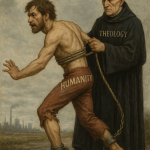WORLD Magazine founder Joel Belz recently world an opinion piece titled “Gay, but Celibate.” In his article—published in WORLD, a conservative publication that bills itself as the evangelical equivalent of TIME—Belz addresses an evangelical trend toward accepting individuals who are open about having same-sex attractions, but vow to live celibate lives. Let’s just say he has a problem with this trend. A big problem.
Because the Catholic Church. But we’ll get to that.
Belz begins his article as follows:
Imagine this scenario. You’re an officer in an evangelical church. The congregation has been thriving and the spirit is good.
But now comes a thunderbolt. Your assistant pastor has just made it known to your church’s leaders that he struggles with a lifelong sexual attraction to other men. Not only that, but he has begun, through social media and otherwise, to let the public know about this. Through his dress, manner, and associations, he demonstrates his preference for a personal identity and lifestyle that is frequently associated with homosexuality. But he assures you that there’s no cause for worry, since he is sexually celibate.
Already there are things that need addressing. For example, what is Belz’s preference? That this assistant pastor, apparently responsible for so much spiritual growth in the church, hide the fact that he has same sex attractions? After all, his same-sex attractions aren’t only there if he mentions them. Silence does not disappear them.
Additionally, what does it mean for someone to demonstrate a “preference for a personal identity and lifestyle that is frequently associated with homosexuality” through one’s “dress, manner, and associations”? I hate to break it to Belz, but leaders in hip evangelical churches today—the kind he seems to be describing—frequently dress in ways our parents’ generation might have found, well, concerning.
Belz’s fascination with “dressing” gay and “acting” gay (whatever exactly he means by this) suggests that his focus is on appearance. What about all the gay men over the years who have worked to hide specific mannerisms or avoid certain forms of dress because they don’t want anyone to find out or suspect? It that better? Belz, it appears, would say yes.
How’s a church to respond? Well, probably not by doing what the Roman Catholic Church has been doing for the last few generations. By most accounts, the Catholic hierarchy has willingly trained and ordained priests who self-identify or are otherwise known as homosexual—all on the promise that they will be celibate.
Hold up. All Catholic priests are expected to be celibate.
After referencing revelations of sexual involvement between priests—and the existence of “homosexual networks” within seminaries—Belz writes the following:
As to sexual abuse of minors, Archbishop Viganò points to the report of the John Jay College of Criminal Justice, which found that over a period of more than 50 years, the vast majority of “child” victims of priests were male (81 percent) and were aged 10 to 17 (86 percent).
Offering positions of church leadership to people who embrace and celebrate sexual disorders, all on the promise they will be chaste, is foolhardy.
Why does Belz place quotations around the world “child”? The only reason to use scare quotes in a situation like this is if he’s suggesting that these aren’t actually children. But ten-year-olds? One could conceivably argue that kids age 14-17 are adolescents rather than children—I’d have issues even then—but 10, 11, 12?
The John Jay report that Belz references does not divide victims into age brackets like “10-17.” It divides them by age, year by year (see p. 70). In other words, just as Belz chose to put scare quotes around the word “child,” even so he chose to group ages 10-17 together. Like many abuse-apologists, Belz is trying to suggest that these were homosexual priests engaging in sexual activity with adolescent males (ignoring the problems here, of course), and not pedophile priests molesting kids. But if that is the case, why group together kids ages 10-17?
My guess is that the 86% stat is just that appealing. If you said that 40% of victims were ages 14-17 (a far better shorthand for adolescent), you’d still be dealing with the other 60% of victims being children, and thus an awful lot of pedophile priests. But if you can say 86% and attach it (however tenuously) to adolescents, you can eschew the pedophile framing (however falsely) and pin the problem on homosexual priests.
(For the curious—yes, that means more victims were ages 10-13 than were ages 14-17, despite the fact that each grouping contains the same number of years. And, because it bears repeating, adolescents ages 16 and 17 are still children, and priests are still both adults and authority figures. A priest grooming and sexually molesting a 17-year-old boy is no different from a youth pastor doing the same to a 17-year-old girl.)
Let’s regroup and take stock of what Belz is trying to do.
In case you think I’m grasping in suggesting that Belz wants to paint sexual abuse within the Catholic Church as a homosexual problem rather than a pedophile problem, Belz states it outright:
Bishop Morlino explained: “There has been a great deal of effort to keep separate acts which fall under the category of now-culturally-acceptable acts of homosexuality from the [publicly]-deplorable acts of pedophilia. That is to say, until recently the problems of the church have been painted purely as problems of pedophilia—this despite clear evidence to the contrary.”
So first, there’s that.
Then, to make things even more clear, Belz offers his argument in a nutshell:
The Roman Catholic Church in America is now paying dearly for buying into the theory that men who embrace a homosexual identity can be church leaders—so long as they promise “chastity.” It is a theory that has been tried and found wanting.
Belz is being highly disingenuous by not addressing the fact that heterosexual clergy are also expected to be celibate. He is also not addressing the fact that sexual abuse happens in evangelical churches. In fact, Boz Tchividjian, a professor at Liberty University and the grandson of Billy Graham, has estimated that evangelical churches have a larger sexual abuse problem than does the Catholic Church.
(The high percentage of Catholic sexual abuse victims who are males is explained partly by ease of access. In the Catholic church, preadolescent and young adolescent boys have long served as alter boys, a role that often involves being alone with a priest while preparing for mass, as well as in other capacities.)
In his framing, Belz is ignoring the real reason a sexual abuse scandal rolling over the Catholic Church—coverup and secrecy. Time and again priests have been shuffled from parish to parish, or retired quietly. The institution is given the priority over the victim. The same thing happens within the evangelical church when an offender is let go by one church only to be hired by another, with no warning from their earlier employer.
That is what has been tried and found lacking—a culture of coverup and institutional prioritization that values the church’s image over the wellbeing of children and other abuse victims. That is why this scandal is having such an impact. And you know what? The evangelical church is not immune. It never has been.
If Belz cares so much about protecting children, he should be writing about the importance of child protection measures of church—about the need for background checks and accountability systems, about the need for taking victims’ reports seriously and the importance for transparency. Instead, the magazine he founded has run columns critical of such measures.
With complete disregard for reality, Belz pretty promises that he cares about children, and that that is why he wants to keep the gays out of the pulpit:
Protestants and evangelicals should be forewarned. Reaching out with helpful compassion to those entrapped by homosexual temptation is one thing. If some of us need to be taught how to be more welcoming on that front, such is altogether within the spirit of this column. There are those who suffer from same-sex attraction who do not celebrate homosexuality as an identity, and who resist their temptation appropriately without inviting scandal.
But offering, or even allowing, positions of church leadership to people who embrace and celebrate sexual disorders, all on the promise they will be chaste, is foolhardy.
Even here, though, Belz’s argument makes no sense. If the gays really were a danger to children, why would he only have a problem with individuals with same-sex attractions who are out about their attractions? His argument seems to be one of don’t ask don’t tell—that so long as a person doesn’t say that they are gay, so long as they aren’t honest or open about their orientation, they’re safe in the ministry.
This suggests that it is not actually about protecting children, and never was. It’s about pushing gays back into the closet and keeping them there. It’s about the appearance of righteousness. Damningly, it’s about secrecy. Hide homosexuality. Keep it secret, not out in the open. It’s not about kids. It’s about appearance.
Belz finishes with this:
So the next time you’re confronted with a candidate for leadership in your own church (or school, or mission, or other institution) who boasts that he is “gay but celibate,” you may do well to remember the clear and present agony of a growing host of your Catholic brothers and sisters. Every single one of the priests who stand guilty of sexual abuse started with a promise of chastity.
So far, I have been analyzing Belz’s piece fairly clinically. I feel the need to state, here, that his article is both horrific and wildly dangerous. Belz is promoting ideas that drive adolescents and young adults to suicide. He is promoting ideas that stigmatize a vulnerable group, ideas that lead to dead kids.
Consider this: one reason for the movement among some evangelicals to except the gay-but-celibate into their congregations and even ministry is a desire to combat the stigma and bigotry that often drives gay youth and others to suicide. You are made in the image of God, these evangelicals say. You are not an abomination.
To be sure, telling someone that they they may never have their own families—that they may never find love or lifelong companionship—is horrific. This growing acceptance of openly gay individuals by some evangelicals, after all, typically comes with a demand for celibacy—whether one is planning to enter the ministry or not. It is a halfway measure that does not go nearly far enough. But consider the alternative.
The alternative is the home in which I grew up, where gay people were referred to as abominations and people shuddered when homosexuality came up. The alternative is what Belz is preaching, a world where gay people are viewed as sexual predators waiting to happen. Because don’t get him wrong, that is what he is preaching—that even if they promise to follow God and remain celibate, gay people are dangerous and not to be trusted.
Unless they hide in the closet, apparently. Hiding in the closet is somehow—inexplicably—acceptable to Belz.
There are those who suffer from same-sex attraction who do not celebrate homosexuality as an identity, and who resist their temptation appropriately without inviting scandal.
Hiding in the closet and hating oneself. Hiding in the closet with no validation for your struggles. Hiding in the closet means being alone. Hiding in the closet, because otherwise people will think you are a child molester. These views kill people. It is Belz, and his views, that are the abomination here. Belz, remember, is no fringe name. He has a lot of influence, and is widely respected in conservative evangelical circles.
And yet here we are.
The courts may have upheld same-sex marriage and the public may increasingly accept gay couples and gay families, but these ideas are still there. In the 1970s, Anita Bryant tried to ban gay individuals from teaching in public schools, because being gay was equated with being a pedophile. In some ways, we have come a long way since those days, but in other ways, we have not come far enough at all.
If Belz actually cared about children, he would care about the gay children who commit suicide each year.
I have a Patreon! Please support my writing!















